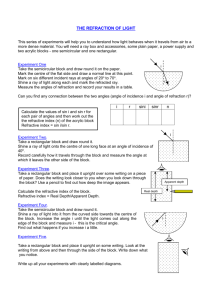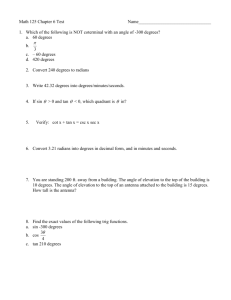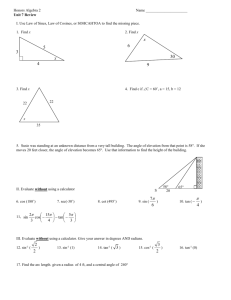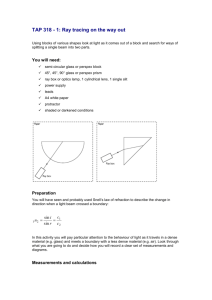PowerPoint
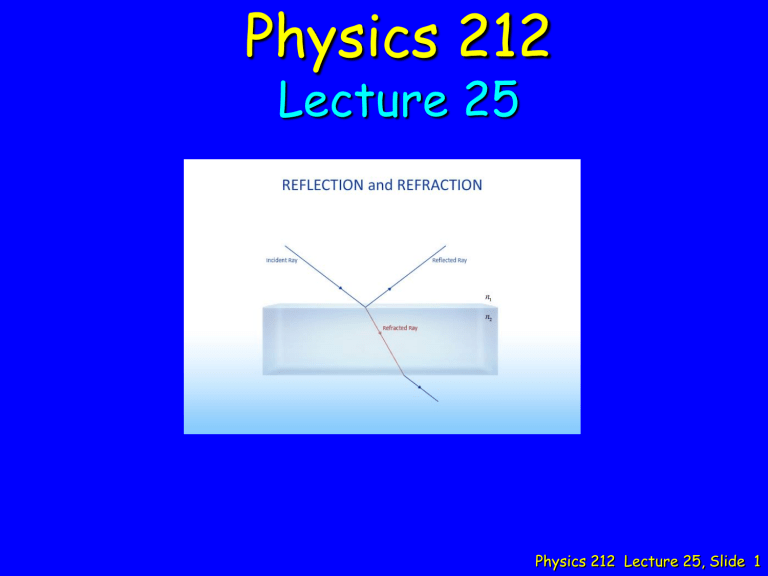
Physics 212
Lecture 25
Physics 212 Lecture 25, Slide 1
Music
Who is the Artist?
A) The Band
B) Bob Seger
C) CCR
D) Eagles
E) Steve Miller Band
We’ve had a few CCR requests
Physics 212 Lecture 24
Your Comments
“Finally! Stuff I actually like and understand!”
“Probably the easiest thing we will ever learn all year.”
“I didn’t really understand the polarized portion, partially because the prelecture slide was 3 minutes of a non moving picture which surely cannot hold my attention when
I’m on a computer. ”
We’ll go over the key steps
“I am confused about the polarization. Why is the horizontal polarization unchanged while the vertical polarization is decreased from incidence to reflected ray??”
“I could use a little more discussion on the polarization due to reflection.”
“I thought the prelecture was pretty straight forward (minus the slide about intensity - uuuhhh a little more explanation por favor!), but then, the checkpoints were a bit trickier than I expected.
Could we go over them please????”
Checkpoints – coming up!
Hour Exam 3: 1 week from tomorrow (Wed. Apr. 25)
• covers L19-26 inclusive (LC circuits to lenses)
• Sign up for conflicts, etc. no later than Mon. Apr. 23 at 10:00 p.m.
05 Physics 212 Lecture 25, Slide 3
Let’s start with a summary:
from n
1 to n
2 from n
1 to n
2
Physics 212 Lecture 25, Slide 4
The speed of light in a medium is slower than in empty space:
since e
0
< e v medium
= c / n medium
Remember:
k
is dielectric constant (capacitors)
Physics 212 Lecture 25, Slide 5
A ray of light passes from air into water with an angle of incidence of 30 degrees.
Checkpoint 1a
Which of the following quantities does not change as the light enters the water?
A. wavelength B. frequency C.
speed of propagation
“frequency depends on speed, which obviously changes”
“frequency doesn’t depend on the medium. Frequency only depends on the source producing the wave”
“Speed of light is always the same.”
Physics 212 Lecture 25, Slide 6
A ray of light passes from air into water with an angle of incidence of 30 degrees.
Checkpoint 1a
Which of the following quantities does not change as the light enters the water?
A. wavelength B. frequency C.
speed of propagation
What about the wave must be the same on either side ???
Observers in both media must agree on the frequency of vibration of the molecules
Physics 212 Lecture 25, Slide 7
Reflection
Physics 212 Lecture 25, Slide 8
Refraction: Snell’s Law
D sin
2 c / n
2
D sin
1 c / n
1 n
2 sin
2
n
1 sin
1
Physics 212 Lecture 25, Slide 9
Think of a day at the beach…
What's the fastest path to the ball knowing you can run faster than you can swim?
Not the quickest route…
This one is better
Physics 212 Lecture 25, Slide 10
A x
1 l
1 y
1
Same Principle works for Light !!
D y
2 l
2 x
2
B
Time from A to B : t
l
1 v
1
l
2 v
2
x
1
2 y
1
2 v
1
x
2
2
y
2
2 v
2
To find minimum time, differentiate t wrt x
1 and set = 0
How is x
2 related to x
1
?
dt dx
1
v
1 x
1 x
1
2 y
1
2 x
2
D
x
1
v
2 dx
2 dx
1
1 x x
2
2
2
y
2
2 dx
2 dx
1
Setting dt/dx
1
= 0 x
1 v
1 l
1
x
2 v
2 l
2
0 sin
1 v
1
sin
2 v
2 v = c/n n
1 sin
1
n
2 sin
2
Physics 212 Lecture 25, Slide 11
The path of light is bent as it passes from medium 1 to medium 2.
Checkpoint 2a
Compare the indices of refraction in the two media.
A. n
1
> n
2
B. n
1
= n
2
C.
n
1
< n
2
“by snell’s law, n1 has to be bigger than n2 to make up for smaller sin(theta1) ”
“They are the same angles. ”
“if theta is smaller, n must be smaller”
Physics 212 Lecture 25, Slide 12
The path of light is bent as it passes from medium 1 to medium 2.
Checkpoint 2a
Compare the indices of refraction in the two media.
A. n
1
> n
2
B. n
1
= n
2
C.
n
1
< n
2
Snell’s Law: n
1 sin
1
= n
2 sin
2 n decreases increases
Physics 212 Lecture 25, Slide 13
Total Internal Reflection
NOTE: n
1
> n
2 implies
2
>
1
BUT:
2 has max value = 90 o !!
1
>
c
Total Internal Reflection
Physics 212 Lecture 25, Slide 14
A light ray travels in a medium with n
1 a medium n
2
.
and completely reflects from the surface of
Checkpoint 2b
The critical angle depends on:
A. n
1 only B. n
2 only C.
both n
1 and n
2
“n1 determines n2 which determines the critical angle”
“Critical angle depends on the incidence angle inside the medium, so only n2 is required. ”
“n1 must be greater than n2”
Physics 212 Lecture 25, Slide 15
A light ray travels in a medium with n
1 a medium n
2
.
and completely reflects from the surface of
Checkpoint 2b
The critical angle depends on:
A. n
1 only B. n
2 only C.
both n
1 and n
2
c clearly depends on both n
2 and n
1
Physics 212 Lecture 25, Slide 16
Intensity
Anything looks like a mirror if light is just glancing off it.
If two materials have the same n then its hard to tell them apart.
Physics 212 Lecture 25, Slide 17
Polarization
56.3
o
Snell’s Law:
1
2
90
n
2 sin
2
n
2 cos
1 sin
2
sin( 90
1
)
cos
1
n
1 sin
1 tan
1
n
2 n
1
Physics 212 Lecture 25, Slide 18
A ray of light passes from air into water with an angle of incidence of 30 degrees.
Checkpoint 1b
Some of the light also reflects off the surface of the water. If the incident light is initially unpolarized, the reflected light will be
A. unpolarized B. somewhat horizontally polarized C.
somewhat vertically polarized
“reflection doesn’t polarize previously unpolarized light.”
“The vertical component of the E field gets smaller as the ray approaches
Brewster's angle.”
“Only vertically polarized light reflects”
Physics 212 Lecture 25, Slide 19
A ray of light passes from air into water with an angle of incidence of 30 degrees.
Checkpoint 1b
Some of the light also reflects off the surface of the water. If the incident light is initially unpolarized, the reflected light will be
A. unpolarized B. somewhat horizontally polarized C.
somewhat vertically polarized o = horizontal
Physics 212 Lecture 25, Slide 20
A ball sits in the bottom of an otherwise empty tub at the front of the room.
Suppose N people sit high enough to see the ball (N = ).
Physics 212 Lecture 25, Slide 21
A ball sits in the bottom of an otherwise empty tub at the front of the room.
Suppose N people sit high enough to see the ball (N = ).
Suppose I fill the tub with water but the ball doesn’t move.
Will more or less people see the ball?
A) More people will see the ball
B) Same # will see the ball
C) Less people will see the ball
??
w
A
Snell’s Law: ray bent away from normal going from water to air
Physics 212 Lecture 25, Slide 22
A light is shining at the bottom of a swimming pool (shown in yellow in the figure). A person is standing at the edge of the pool.
Checkpoint 3
Can the person standing on the edge of the pool be prevented from seeing the light by total internal reflection at the water-air surface?
A. yes B. no
“light could all be relected and stay in the water so he can’t see it ”
“it depends on the position of the light. if it’s too close to the person, they won't see it.”
“Light comes out at many angles, so while some may be interneally reflected, all cant since they are at differnet angles”
“There would be a point where some light would be totally reflected but that would only be for a point, not for the whole light.”
Physics 212 Lecture 25, Slide 23
A light is shining at the bottom of a swimming pool (shown in yellow in the figure). A person is standing at the edge of the pool.
Checkpoint 3
Can the person standing on the edge of the pool be prevented from seeing the light by total internal reflection at the water-air surface?
A. yes B. no
The light would go out in all directions, so only some of it would be internally reflected. The person would see the light that escaped after being refracted.
DRAW SOME RAYS
Physics 212 Lecture 25, Slide 24
Example: Refraction at water/air interface
• Diver’s illusion
air
90
97 º
Diver sees all of horizon refracted into a 97°cone sin
water n a n w sin90
n a
n w
1
1.33
water
48.5
Physics 212 Lecture 25, Slide 25
Exercise
A meter stick lies at the bottom of a rectangular water tank of height 50cm.
You look into the tank at an angle of
45 o relative to vertical along a line that skims the top edge of the tank.
What is the smallest number on the ruler that you can see?
45 o
50 cm
0 n water
= 1.33
20 40 60 80 100
Conceptual Analysis:
- Light is refracted at the surface of the water
Strategy:
- Determine the angle of refraction in the water and extrapolate this to the bottom of the tank.
Physics 212 Lecture 25, Slide 26
Exercise
A meter stick lies at the bottom of a rectangular water tank of height 50cm.
You look into the tank at an angle of
45 o relative to vertical along a line that skims the top edge of the tank.
What is the smallest number on the ruler that you can see?
45 o
50 cm
0 n water
= 1.33
20 40 60 80 100
If you shine a laser into the tank at an angle of 45 o , what is the refracted angle
R in the water
?
A)
R
=
28.3
o
B)
R
=
32.1
o
C)
R
=
38.7
o
Snell’s Law: n air sin(45) = n water sin(
R
) sin(
R
) = n air sin(45)/n water
= 0.532
R
= sin -1 (0.532) = 32.1
o
Physics 212 Lecture 25, Slide 27
Exercise
A meter stick lies at the bottom of a rectangular water tank of height 50cm.
You look into the tank at an angle of
45 o relative to vertical along a line that skims the top edge of the tank.
What is the smallest number on the ruler that you can see?
45 o
50 cm
R
0 d
20
What number on the ruler does the laser beam hit ?
n water
= 1.33
40 60 80 100
R
= 32.1
o
A) 31.4 cm B) 37.6 cm C) 44.1 cm tan(
R
) = d/50 d = tan(32.1) x 50cm = 31.4cm
Physics 212 Lecture 25, Slide 28
Follow-Up
A meter stick lies at the bottom of a rectangular water tank of height 50cm.
You look into the tank at an angle of
45 o relative to vertical along a line that skims the top edge of the tank.
45 o
50 cm n water
= 1.33
0 20 40 60 80 100
If the tank were half full of water, what number would the laser hit?
(When full, it hit at 31.4 cm)
A) 25 cm B) 31.4 cm C) 32.0 cm D) 40.7 cm E) 44.2 cm
Physics 212 Lecture 25, Slide 29
45 o 45 o n water
= 1.33
50 cm
R
0
R
20
= 32.1
o d = 31.4 cm
40 60 80 100
45 o
50 cm
0 d = 50 cm
20 40 60 80 100
50 cm
R n water
= 1.33
d = 40.7 cm
0 20 40 60 80 100
25 cm + (31.4/2) cm Physics 212 Lecture 25, Slide 30
More Practice
A monochromatic ray enters a slab with n
1
= 1.5 at an angle b as shown
b
TOP
BOTTOM n = 1 n
1
= 1.5
n = 1
b
(A) Total internal reflection at the top occurs for all angles b
, such that sin b
< 2/3
(B) Total internal reflection at the top occurs for all angles b
, such that sin b
> 2/3
(C) There is no angle b
(0 < b
< 90 o ) such that total internal reflection occurs at top.
Snell’s law: n
1 sin
1
n
2 sin
2 nsin is “conserved”
Ray exits to air with same angle as it entered !!
Physics 212 Lecture 25, Slide 31
Follow-Up
A ray of light moves through a medium with index of refraction n upon a second material ( n
2
) at angle
1 at the interface with a third material ( n
3
1 and is incident as shown. This ray is then totally reflected
). Which statement must be true?
n
1 n
2 n
3
1 n
n n
1
n
3
n
2 n
3
n
2
If n
1
= n
3 n
1 n
2 n
3
1
1
Want larger angle of refraction in n
3 n
3
< n
1
Physics 212 Lecture 25, Slide 32
